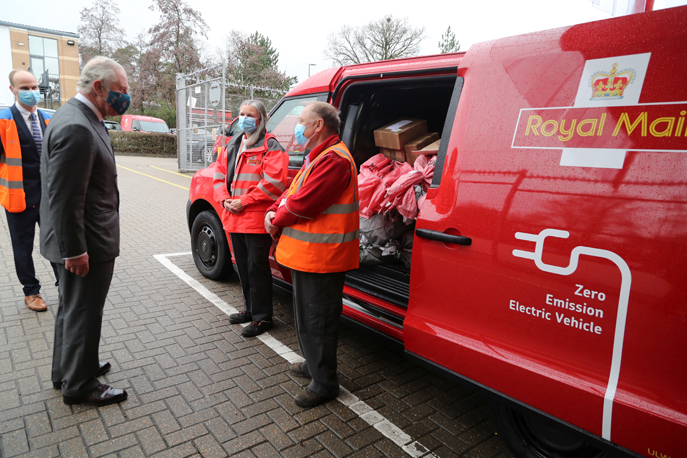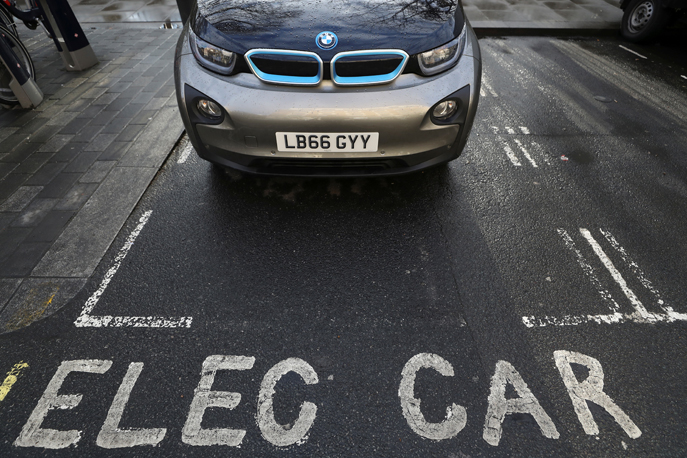Centrica, BT, Royal Mail and DPD are among a Climate Group-convened coalition of fleet operators that is supporting the UK’s transition to EV by 2030. Mike Scott reports
The electric vehicle (EV) market is at a tipping point, which makes for some interesting and apparently contradictory statistics. While the market for low-carbon vehicles has grown by 128% in the past two years, EVs still make up just 2% of the UK market, according to telematics group Masternaut.
There is no doubting the direction of travel, though. The UK government’s recent move to bring forward its ban on the sale of new internal combustion engine (ICE) vehicles to 2030 is just
the latest signal that the future of transportation is electric.
One of the key drivers of a speedy roll-out of EVs will be the corporate fleet market, says Sandra Roling, head of the Climate Group’s EV100 initiative, a global initiative that now numbers 101 companies that have committed to switch their fleets to EVs or install charging stations for customers and staff by 2030.
“Two-thirds of new cars are bought by companies, so the decisions they make will have a big impact on the overall market, as well as feeding through to the second-hand market. If we convince one company to go electric, that can mean a few thousand vehicles,” Roling says.
Companies want to reap the reputational benefits available for early adopters
Companies are switching to electric transport because they want to demonstrate climate leadership, recognise the need to tackle air pollution and want to reap the reputational benefits available for early adopters, she says.
Alberto De Monte, director for sustainable mobility at Masternaut, says drivers for UK fleets include “the increasing pressure on companies to reduce emissions from transport, the introduction and extension of ultra-low emissions zones and the start of the corporate car incentive in April 2020”.
Deloitte calculates that the new tax rules for company cars can reduce the total cost of ownership to an employee by an astonishing 95% if they choose an EV.

At the same time, manufacturers have put more models on the market, increasing choice and helping to drive down prices. BloombergNEF predicts that from next year the first EVs will cost the same as ICE vehicles, with price-parity for the average car coming in 2025. “Once you reach that point, buying an EV is a no-brainer,” Roling says.
But fleets are already electrifying because EVs are cheaper now in terms of the total cost of ownership. Amazon, which has pledged to buy 100,000 electric delivery vans, has started testing vehicles, while IKEA says all its deliveries will be electric by 2025.
Earlier this month, FedEx announced that all of its 200,000 delivery vehicles will be electric by 2040. That move follows President Joe Biden’s pledge to replace 650,000 U.S. federal government vehicles with electric models (see Biden’s EV plan puts charge through U.S. auto industry).
Even though trucks and tractor trailers make up only about 4% of vehicles on U.S. roads, they are responsible for nearly half the nitrogen oxide emissions
Jason Mathers, director of vehicles and freight strategy at the Environmental Defense Fund, explains why such commitments are so important. “Even though delivery trucks and tractor trailers make up only about 4% of vehicles on U.S. roads, they are responsible for nearly half of the nitrogen oxide emissions and nearly 60% of the fine particulates from all vehicles, and about 7% of all greenhouse gas emissions in the U.S.”
In the UK, BT joined forces in the Climate Group to form the UK Electric Fleets Coalition, which includes the four biggest commercial fleets: Centrica, BT, Royal Mail and DPD UK.
Such announcements send a clear message to policymakers and manufacturers, says Penelope Guarnay, carbon programme manager, digital impact and sustainability at BT. The group has already achieved its first aim, which was to bring forward the UK phase-out of petrol and diesel vehicles to 2030, from its original date of 2040.

Although manufacturers such as Ford, GM and Volvo have announced plans to accelerate their rollout of EV models (see GM comes from behind to vie for pole position in electric vehicle race), the coalition wants to see a zero-emission vehicle mandate requiring all manufacturers “to ensure an annually increasing percentage of zero-emission vehicle sales to underpin the internal combustion engine phase-out”.
It also wants to see grants for vans extended beyond 2023, as they are not set to reach price-parity until the late 2020s. One key sticking point in corporate fleets leading the way in the electrification of transport is that many of the vehicles in those fleets are vans, and there is a limited supply and choice, in part because of the particular challenges of electrifying commercial vehicles. As a result, progress has been slow.
“Our engineers’ vans carry a lot of kit, which makes them heavier than the average load and affects the range of the vehicles,” says Guarnay. “Unfortunately, battery technology and availability of public charging is not yet there to make an EV van suitable for all our engineers. They are great in cities, where average daily mileage is below 60 miles, but in rural areas they might have to do a few hundred miles a day. To do that, they not only need adequate battery range but also to accommodate ultra-rapid charging, which is something that is not yet standard in all EV vehicles.”
The major factor has been the availability of EVs, especially appropriate vans for our payloads and operational model
Having taken delivery of its first electric van in February, BT plans to have 250 electric vans on the road by the end of March 2021 and one third of all vehicles in its Openreach unit, which comprises about 80% of its fleet, to be electric by 2030.
Centrica, an energy services company with 9 million customers, mainly in the UK and Ireland, says it has been working on electrifying its fleet since 2012. The company put 1,000 vans on the road last year and has just placed an order for 2,000 more, with the aim to be fully electric by 2025. “The major factor has been the availability of EVs, especially appropriate vans for our payloads and operational model,” says Lucy Simpson, head of product for EV enablement, UK and Europe, at Centrica Business Solutions. “But new models are coming on the market all the time.”
That means that one of the biggest remaining barriers is the availability of charging points. BT and Centrica are installing chargepoints both at their own premises and at the homes of their engineers. But sometimes, drivers will need to charge on the street, either while they are on the job or because they do not have off-street parking at home.

A recent report from the National Audit Office said that the government “has not yet focused sufficiently on chargepoint availability for people who do not have a driveway”.
More chargepoints are also needed in hotels, supermarkets and leisure centres, as well as in workplaces. “EV-friendly workplaces are essential in the roll-out of electric mobility, especially as more employees return to the office once restrictions are lifted,” says Adam Hall, head of electric vehicles at Drax Group. “Most EV drivers want to charge their vehicle while they’re at work, as this is a convenient time. Therefore, their employers should make sure that the right charging infrastructure is available. Without it, employers are at risk of deterring their employees from making the switch.”
Another issue is that the cost of charging varies widely. Research from What Car shows that the average cost of charging at home is around 14p/kWh while the cost of charging a BMW iX3 varies between £40.66 in parts of central London (which includes a £10 one-off charge) to £11.91 using Pod Point’s facilities.
We are accelerating our own EV transition and very much want to support other fleets across the UK
Network capacity also varies and in areas where it is constrained it can be very costly to upgrade it, says Guarnay.
However, a number of companies, including Centrica and Drax, have started offering services that can help companies to speed up their switch to electric, from installing and maintaining chargepoints to integrating them with renewable power sources such as solar and batteries.
“We want to help fleets get the best value out of their vehicles and batteries,” says Simpson. “We are accelerating our own EV transition and very much want to support other fleets across the UK in their transition.”
Mike Scott is a former Financial Times journalist who is now a freelance writer specialising in business and sustainability. He has written for The Guardian, the Daily Telegraph, The Times, Forbes, Fortune and Bloomberg.
This article is part of the in-depth Sustainable Transport briefing. See also:
Rethinking the commute to work post Covid-19
Biden’s EV plan puts charge through U.S. auto industry
Can Chile avoid resource curse from lithium?
From cul-de-sac to second life for redundant car batteries
Will green hydrogen fulfill high hopes for trucking and shipping emissions?
Sustainable aviation fuels get powerful boost from pandemic
Indonesian rush to biodiesel raises fears about spike in deforestation risk
EV electric vehicles BT DPD EV100 Fedex UK Electric Fleets Coalition Climate Group Masternaut Environmental Defense Fund Ikea


